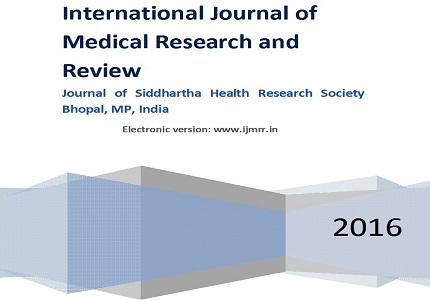Perception of objective structured clinical examination and traditional practical examination in assessment of nursing students clinical competencies by nursing students in south west Nigeria
Abstract
Background: Clinical examination is a crucial part of nursing training programmes for assessing nursing student competencies which ultimately lead to the delivery of quality nursing care. Two methods of clinical assessment have been identified [Traditional Practical Examination (TPE) and Objective Structured Clinical Examination(OSCE)] in nursing and allied professions globally. Nursing and Midwifery Council of Nigeria (N&MCN) had always used TPE for all clinical examinations in nursing but adopted OSCE two decades ago for only midwifery examination while the examination in general nursing still remains TPE. There is dearth of literature on the perception of these two methods in Nigeria hence this study. This will help to determine best preferred method for clinical assessment among nursing students in Nigeria.
Methods: The study utilised one-group quasi experimental design. Two Hospital-based and two University-based nursing schools randomly selected in South-west Nigeria participated in the study. Purposive sampling technique was used to select 187 nursing students out of which 157 participated in the study. T-test, ANOVA and chi-square were used to analyze the data at 0.05level of significance.
Results: Significant difference existed between the mean scores of the two practical examinations: TPE 59.31+2.92, OSCE 64.59+5.15, t=3.29, p=0.002. OSCE was perceived to be more objective compared to TPE, p=0.000, consume less time p=0.010, assessed wider range of learned materials, p=0.000, less destabilizing during practical session, p=0.001, less stressful p=0.002. Perception on which method demands more preparation showed no significant difference between OSCE and TPE, p=0.097. Lastly, 56.8% of participants preferred OSCE to TPE, p=0.001.
Conclusion: OSCE is perceived to be a better method than TPE. It is recommended that OSCE should be adopted as method of practical examination for nursing training programmes in Nigeria.
Downloads
References
2. Bujack, L., McMillan. M., Dwyer, J., and Hazeton, M.2004. Assessing comprehensive nursing performance: the Objective Structural Clinical Assessment (OSCA) Part 1 — Development of the assessment strategy retrieved June, 12th 2012 from http:www.sciencedirect.com Retrieved 12th Jan 2012, from http://www.nmcuk. org.
3. Cassidy S. Subjectivity and the valid assessment of pre-registration student nurse clinical learning outcomes: implications for mentors. Nurse Educ Today. 2009 Jan;29(1):33-9. doi: 10.1016/j.nedt.2008.06.006. Epub 2008 Aug 15.
4. El-Nemer, A and Kandeel, N. 2009. Using OSCE as an Assessment Tool for Clinical Skills: Nursing Students' Feedback Australian Journal of Basic and Applied Sciences, 3(3): 2465-2472.
5. Eman, A.M.M., Elsayeda, I.A., Amel, A.E., Mona, A.E. and Mastoura, K.F. 2014. The Impact of the Objective Structured Clinical Examination Approach for Clinical Evaluation Skills on the Student's Performance in Nursing College World Journal of Medical Sciences 2014;11 (4): 609-613.
6. Hassan, s., Malik,S., Hamad,A., Khab, H. and Bilal, M. 2009. Conventional/Traditional
Practical Examination(CPE/TDPE)Versus Objective Structured Practica Evaluation(OSCE)/Semi Objective Structured Practical Evaluation(SOSCE). Pak. J.Physiol 2009:5(1). Retrieved March 30, 2013 from htt\p:/www.pps,org.pk
7. Jafarzadeh, A. 2009. Designing the OSCE method for evaluation of practical immunology course of medical students: in comparison to written-MCQ and Oral examination. Retrieved March 30, 2013 from www.scopemed.org.
8. Jones, E.A., Voorhees, R.A and Paulson., K. 2002. Defining and Assessing Learning: Exploring Competency-Based Initiatives, National Center for Education Statistics Office of Educational Research and Improvement U.S. Department of Education.
9. Linda, Schoene & Kanusky, 2007. The Role of the Clinical Educator in Evaluating. Part of the Education Commons, and the Nursing Administration Commons. Retrieved 30th September 2013from http://digitalcommons.library.tmc.edu/uthshis_atldayabs
10. Ngatia P.M. and Mutema, A.M. 2006. Principles and practices of problem based Learning. AMREF and MOI University Press, Kenya.
11. Om Lata, B, Bharti, B., Bharati, M., and Sabyasachi, S126. 2014. Objective Structured Practical Examination and Conventional Practical Examination: a Comparison of Scores Journal of Medical Educators.
12. Ross M, Carroll G, Knight J, Chamberlain M, Fothergill-Bourbonnais F, Linton J. Using the OSCE to measure clinical skills performance in nursing. J Adv Nurs. 1988 Jan;13(1):45-56.
13. Shadia A.E. and Nagwa A.A.H. 2013. Objective Structured Clinical Evaluation (OSCE) versus Traditional Clinical Students Achievement at Maternity Nursing: A Comparative Approach. IOSR Journal of Dental and Medical Sciences (IOSR-JDMS) e-ISSN: 2279-0853, p-ISSN: 2279-0861. Volume 4, Issue 3 (Jan.-Feb. 2013), PP 63-68 www.iosrjournals.org retrieval date February 28th , 2016
14. Smith LJ, Price DA, Houston IB. Objective structured clinical examination compared with other forms of student assessment. Arch Dis Child. 1984 Dec;59(12):1173-6.
15. Supriya D. M, Kartik N. S and Varsha J. P, 2013. Objective structured practical examination as a tool for the formative assessment of practical skills of undergraduate students in pharmacology J Educ Health Promot. 2: 53 Medknow Publications. Retrieved 28th Nov.2014
16. Wadde, S. K., Deshpande, R. H., Madole, M. B. and Pathan, F. J. 2013. Assessment of III MBBS Students using OSCE in Community Medicine: Teachers’ and students’ Perceptions. Sch. J. App. Med. Sci., 2013; 1(4):348-353.
17. Wikipedia, 2010. Objective structured Clinical Examination en.wikipedia.org/wiki/ Objective Structured Clinical Examination. Retrieved 11th November, 2014



 OAI - Open Archives Initiative
OAI - Open Archives Initiative


